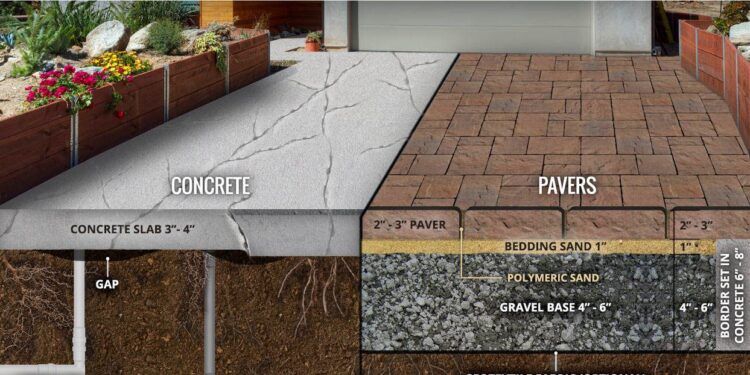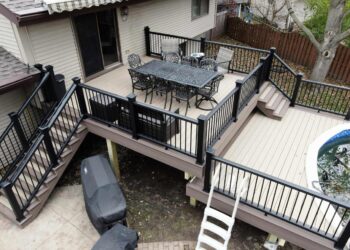When it comes to outdoor spaces, the choice between a concrete patio and a paver patio can make a significant impact on the aesthetics and functionality of your area. Let's delve into the details of each option to help you make an informed decision that suits your needs and preferences.
Pros and Cons

When deciding between a concrete patio and a paver patio, it's important to consider the advantages and disadvantages of each option to make an informed choice that suits your needs and preferences.
Advantages of a Concrete Patio
- Durability: Concrete patios are known for their long-lasting durability, making them a solid investment for your outdoor space.
- Low Maintenance: Concrete patios require minimal maintenance, with occasional sealing and cleaning being sufficient to keep them looking good.
- Customization: Concrete can be easily stamped, stained, or colored to achieve a variety of looks and patterns to match your aesthetic preferences.
- Cost-Effective: Concrete is generally more affordable than pavers, making it a budget-friendly option for those looking to save on installation costs.
Benefits of Choosing a Paver Patio
- Design Flexibility: Pavers come in a wide range of colors, shapes, and sizes, allowing for endless design possibilities to create a unique outdoor space.
- Easy Repairs: In the event of damage, pavers can be easily replaced individually without the need to redo the entire patio, saving time and money.
- Strength: Pavers are known for their strength and ability to withstand heavy loads, making them ideal for high-traffic areas.
- Enhanced Aesthetics: The natural look and texture of pavers can add character and charm to your outdoor space, enhancing its overall appeal.
Drawbacks of Concrete Patios
- Cracking: Concrete is prone to cracking over time, especially in extreme weather conditions or if not properly installed.
- Lack of Repair Options: Once a concrete patio cracks, repairs can be challenging and may result in visible patches that affect the overall look.
- Limited Design Options: While concrete can be customized to some extent, it may not offer the same level of design flexibility as pavers.
Disadvantages Specific to Paver Patios
- Weed Growth: Paver patios can be susceptible to weed growth between the joints, requiring regular maintenance to keep them weed-free.
- Uneven Surface: Over time, pavers may shift or settle, resulting in an uneven surface that may require readjustment to maintain a level patio.
- Higher Installation Costs: Paver patios tend to be more expensive to install compared to concrete, which can be a deterrent for those on a tight budget.
Durability
Concrete patios are known for their exceptional durability. Once properly installed and sealed, concrete can withstand heavy foot traffic, furniture, and various weather conditions without deteriorating quickly. With regular maintenance, such as resealing every few years, a concrete patio can last for decades.
Longevity of Paver Patios vs. Concrete Patios
Paver patios are also durable but may require more maintenance compared to concrete. The individual pavers can shift over time due to settling of the base material or the growth of weeds between the joints. However, if properly installed and maintained, a paver patio can last just as long as a concrete one.
Impact of Weather Conditions
- Concrete patios may crack in freezing temperatures if not properly installed or sealed. The expansion and contraction of the material due to temperature changes can lead to cracks.
- Paver patios can be affected by frost heave, where the ground freezes and lifts the pavers. This can cause uneven surfaces and potential tripping hazards.
- In areas with high humidity and frequent rainfall, both concrete and paver patios can develop mold or mildew if not cleaned regularly.
Cost Analysis
When it comes to choosing between a concrete patio and a paver patio, cost is a significant factor to consider. Let's break down the cost considerations for each option to help you make an informed decision.
Cost Considerations for Concrete Patio
Installing a concrete patio typically involves lower upfront costs compared to a paver patio. The materials needed for a concrete patio, such as concrete mix, reinforcement, and finishing, are generally less expensive. However, labor costs can vary depending on the complexity of the design and the size of the patio.
- Initial cost savings on materials
- Potential for higher labor costs
- Minimal maintenance expenses
Financial Aspects of Opting for a Paver Patio
On the other hand, a paver patio usually comes with higher upfront costs due to the cost of the individual pavers and the base materials required for installation. While the initial investment may be higher, paver patios offer more design flexibility and can be easier to repair in case of damage.
- Higher initial costs for materials
- Potential for lower labor costs
- Possible savings on repairs and replacements
Long-Term Cost Savings
In the long run, concrete patios may require less maintenance and repair compared to paver patios. Concrete is generally more durable and resistant to wear and tear over time. This could result in lower maintenance expenses and fewer replacements in the future.
However, paver patios offer the advantage of being able to replace individual pavers if they get damaged, which can be a cost-effective solution compared to repairing a concrete patio.
Design Options

Concrete patios and paver patios offer a wide range of design options to enhance the aesthetics of outdoor spaces. Let's explore the design flexibility provided by each type of patio.
Concrete Patios
Concrete patios can be customized in various ways to suit different preferences and styles. Some design options include:
- Stained concrete for a unique and colorful look
- Stamped patterns to mimic the appearance of natural materials like stone or brick
- Exposed aggregate for a textured surface with added visual interest
- Integral coloring to achieve a consistent hue throughout the patio
Paver Patios
Paver patios also offer a wide array of design choices, allowing for creativity and personalization. Here are some design options available with pavers:
- Herringbone, basketweave, or running bond patterns for a classic look
- Multiple color options to create intricate designs or bold contrasts
- Different shapes and sizes of pavers for a unique layout or geometric patterns
- Combination of paver materials like concrete, brick, or natural stone for a diverse aesthetic
Both concrete and paver patios can significantly enhance the overall aesthetics of outdoor spaces. Whether you prefer the sleek and modern look of stained concrete or the timeless charm of brick pavers, there are design options available to create a patio that complements your outdoor environment beautifully.
Conclusive Thoughts

In conclusion, both concrete and paver patios offer unique advantages and considerations. Whether you prioritize durability, cost, design, or a combination of factors, understanding the differences between the two can guide you towards creating the perfect outdoor space for your home.







